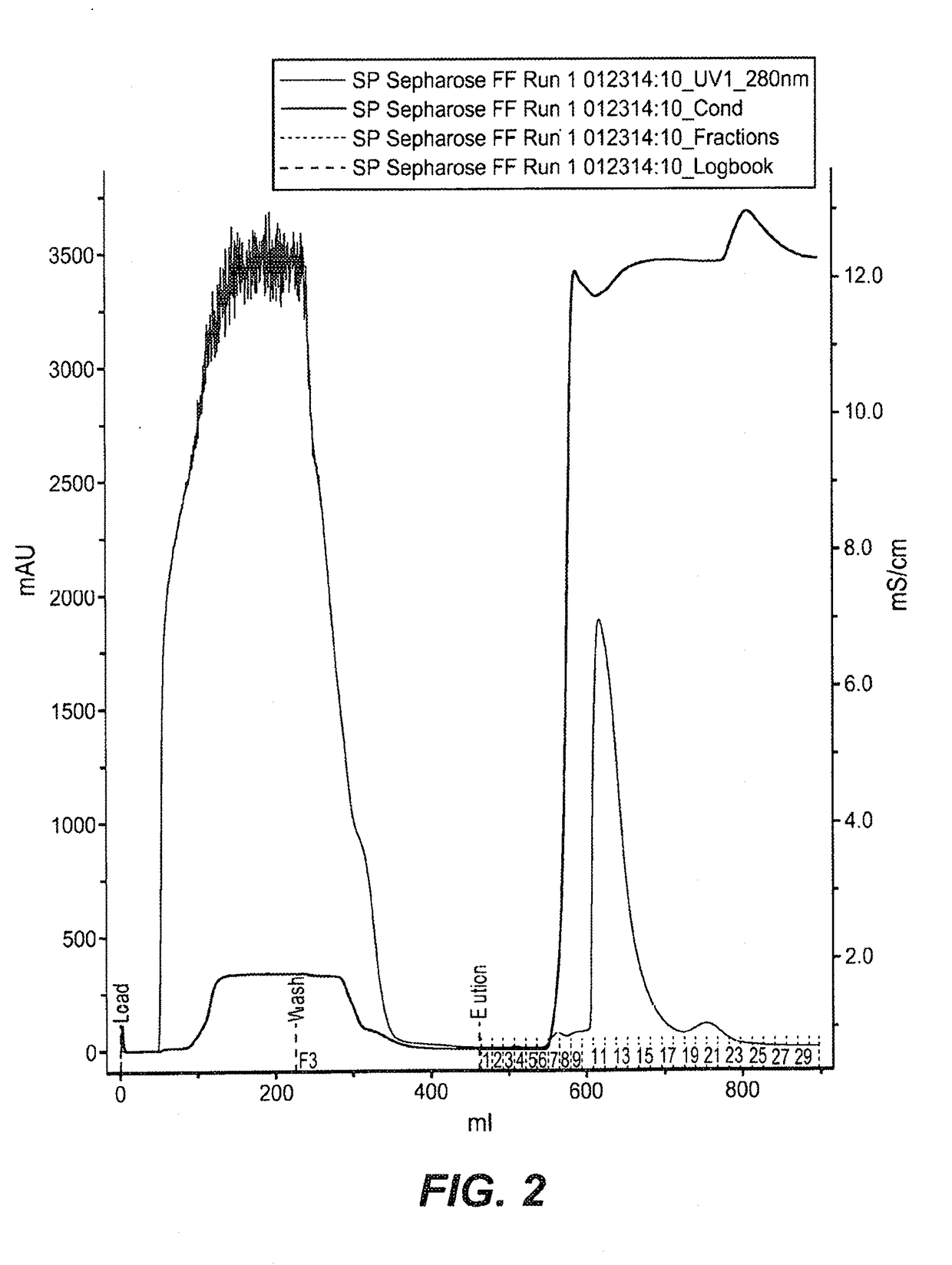Purification of fkpa and uses thereof for producing recombinant polypeptides
a technology of fkpa and polypeptides, which is applied in the field of purification of fkpa and its use in the production of recombinant polypeptides, can solve the problems of insufficient specificity and sensitivity of commercial reagents or analytical methods, and the inability of assays and reagents to accurately detect accessory protein impurities such as fkpa
- Summary
- Abstract
- Description
- Claims
- Application Information
AI Technical Summary
Benefits of technology
Problems solved by technology
Method used
Image
Examples
example 2
on of Ultrapure FkpA
Materials and Methods
Extraction Step
[0454]FkpA was expressed in E. coli (W3110 derivative named 66F8: ΔfhuA ΔphoA ilvG2096 (Valr) Δprc spr43H1 degP ΔmanA lacIQ ΔompT ΔmenE). To do so, compatible plasmids (pACYC, Novagen, Madison, Wis.) were constructed containing the ORF for FkpA, as described in EP1356 052 (see e.g., Examples 9-10, in particular paragraph [0207]). 0.5 mL of frozen stock culture (containing 10-15% DMSO) was thawed and used to inoculate a 2 L shake flask containing 500 mL of Soy LB medium supplemented with 2 mL of kanamycin solution (5 mg / mL) and 2.5 mL 1 M sodium phosphate solution. The culture was expanded to large scale culture. A 50 mL bolus addition of 200 mM IPTG was added to the fermentation at an approximate OD of 200. IPTG was used to induce the tacII promoter used to control the expression of the FkpA open reading frame (ORF). The fermentation run duration was 50 hours.
[0455]All cell lysis and centrifugation steps were carried out at 2-8...
example 3
n and Purification of Anti-FkpA Antibodies
[0545]Polyclonal antibodies were generated against ultrapure FkpA for use in assays to measure the removal of FkpA in the preparation of therapeutic polypeptides. The following example describes the purification methods used to generate the polyclonal FkpA antibodies. These reagents, along with the FkpA immunogens, were required for the development of the specific FkpA ELISA.
[0546]Three rabbits were immunized with the ultrapure FkpA. At day 42, blood was drawn from individual rabbits and the FkpA antisera were used for the purification of anti-FkpA antibodies. Antisera and pre-immunization sera from rabbits A, B, and C were assayed by direct binding ELISA. Ultrapure FkpA was diluted to 4 μg / mL in carbonate buffer, pH 9.6 and coated directly on a Costar 96-well plate (catalog #9018) and incubated at 2-8° C. for 12 to 72 hours. Each well was washed and aspirated with approximately 400 μL of Wash Buffer (phosphate buffered saline (PBS) and 0.05...
example 4
of Ultrapure FkpA
Stability of Ultrapure FkpA Stored at −70%.
[0598]To test the stability of ultrapure FkpA as assay controls, the Standard Stock I, described in Example 2, was diluted in assay diluent to 3 (low), 15 (mid), 75 (high) ng / mL, aliquoted and stored at ˜70° C. The concentration of one low, mid, and high aliquot was measured by ELISA using a standard curve prior to freezing. The stability of low, mid, and high ultrapure FkpA controls was monitored for a total of 18 days by thawing an aliquot and determining the concentration of FkpA. Low controls were unstable when stored at −70° C. Mid controls showed similar instability, however, high controls appeared to be stable when stored at −70° C.
Stability of Ultrapure FkpA Stored at 2-8° C. Compared to −70° C.
[0599]A second test was performed on a new set of low and mid controls with half stored at −70° C. and the other half at 2-8° C. for a total of 8 days. Concentrations were not measured prior to freezing. As in previous experi...
PUM
| Property | Measurement | Unit |
|---|---|---|
| pH | aaaaa | aaaaa |
| pH | aaaaa | aaaaa |
| molecular weights | aaaaa | aaaaa |
Abstract
Description
Claims
Application Information
 Login to View More
Login to View More - R&D
- Intellectual Property
- Life Sciences
- Materials
- Tech Scout
- Unparalleled Data Quality
- Higher Quality Content
- 60% Fewer Hallucinations
Browse by: Latest US Patents, China's latest patents, Technical Efficacy Thesaurus, Application Domain, Technology Topic, Popular Technical Reports.
© 2025 PatSnap. All rights reserved.Legal|Privacy policy|Modern Slavery Act Transparency Statement|Sitemap|About US| Contact US: help@patsnap.com



